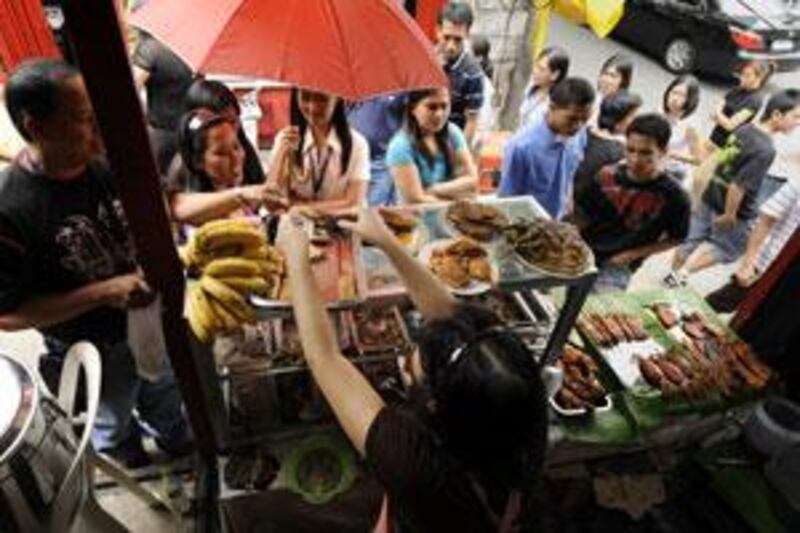Filipino street food is exciting, intriguing and most of all tasty. An epicurean journey to the country is best conducted on the streets where the locals feast on these creative concoctions like a sacred ritual. Wherever you may be, an abundance of Filipino hospitality and uniqueness can be found and cherished in informal dining venues. Malay in origin, Filipino food today is a combination of colonial influences from Spanish, Japanese, and American rule. It's a hybrid delicacy with an Asian soul, owing its richness and flavour to the bounty of the sea and the harvest of the country's fertile islands. A typical Filipino meal is steamed white rice served along with a viand (hot dish of meat, fish or vegetables). Another way to describe it is a dish swimming in grease. And how Filipinos love grease - most stews and soups have a thick layer of oil on the surface. Grills are smothered with oily marinades. While Filipino food has yet to gain prominence in international gastronomy, street food is enjoyed by a cross-section of society. With snacks, complete meals and desserts all on display, food is available virtually anytime and anywhere. From individual stalls, makeshift counters in motorised vans, food hawkers on bikes, on carts, or on foot, Filipinos have elevated street food into a way of life. Many food stalls are set up to resemble a carinderia, or restaurant. On the street, stools are lined up, with pots laden on large rectangular tables in front where customers can point out (turo) which dish they prefer. Hence, the stalls carry the moniker, turo-turo. Dining in a turo-turo is cheap and delicious with home-cooked meals prepared with the same love and care as those by mum. Here, traditional Filipino favourites are served, including Adobo (meat - usually cuts of pork and chicken, stewed in vinegar and soy sauce flavoured with garlic), Pinakbet (mixed vegetables with fermented shrimp paste), Dinuguan (blackened soup of pork blood with vinegar) and Pancit (egg noodles with vegetables). Most street food is somewhat indelicately referred to using slang names, many of which incorporate features of popular culture or daily life. For example, Adidas is grilled chicken feet; IUD (intrauterine device) is chicken intestine skewered on bamboo sticks; Walkman is skewered pork ears; Betamax is skewered chicken blood roasted on coals that are cut into small cubes. Maybe the item if it were popular in the West would be called VHS, but Betamax tapes were more popular in the Asian region during the1980s. Other local favourites include Kwek-kweks, which are soft boiled, deep fried quail's eggs drenched in funny looking orange-coloured batter; tokneneng, which is a chicken egg in a similar coating. Doused with spiced vinegar, these egg wonders are a perfect snack. Cicharon bulaklak is deep fried pork intestine that resembles floral blooms, or bulaklak. It is usually dipped in vinegar with a little salt, chopped onions and garlic, and siling labuyo, or red hot chilli peppers. The dish is best eaten with rice. "Make tusok-tusok the fishball," is a phrase that gained prominence from Manila's youth. Fishballs or squidballs are sold on specially made carts that are equipped with a single gas stove and a Chinese wok for deep frying. The "balls" are skewered (tusok) on bamboo sticks and dipped in a variety of savoury sauces: sweet, spicy and sour vinegar. For dessert, fritters are fondly called the "Q" as in the word "queue". Banana-Q or camote-Q (sweet potato), for example, are skewered orbs deep fried to golden brown perfection and coated with caramelised brown sugar that crumbles in every bite. Halo-halo, which literally means to mix, is a divine concoction of preserved fruits with shaved ice, sweetened milk and ice cream. Notably, the Filipino street food scene is not complete without the notoriously popular balut, boiled duck eggs. Shouting "Balut, Balut," deep into the night like a town crier, the balut vendor arrives like clockwork every evening when it gets dark. Why is the dish sold only at night? Baluts are said to be aphrodisiacs. The food is an acquired taste and it's not for nothing that Balut is so often a feature of I-dare-you-to-do-it reality shows like Survivor, Truth or Dare, and Fear Factor. The eggs are neatly packed in special rattan baskets that are covered with layers of cloth to insulate the heat. Once cracked open, the shell will reveal an entire fertilised duck embryo - the yolk encircling a young chick with feathers. All sprinkled with rock salt for added flavour and eaten.
A hybrid delicacy with Asian soul
The protocol Most street food is referred to using slang names incorporating features of popular culture or daily life. For example, Adidas is grilled chicken feet.

Editor's picks
More from The National




